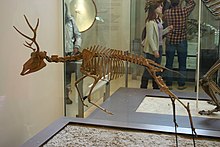Ramoceros
| Ramoceros | |
|---|---|
 |
|
| Ramoceros osborni skeleton | |
| Scientific classification | |
| Kingdom: | Animalia |
| Phylum: | Chordata |
| Clade: | Synapsida |
| Class: | Mammalia |
| Order: | Artiodactyla |
| Family: | Antilocapridae |
| Genus: | †Ramoceros |
| Species: | †R. osborni |
| Binomial name | |
|
Ramoceros osborni |
|
Ramoceros is an extinct genus of the artiodactyl family Antilocapridae endemic to Miocene and Pliocene North America.
Ramoceros is one of several genera that originated from the subfamily Merycodontinae, of which the pronghorn is the only surviving remnant. In fact, pronghorn is the only surviving remnant of the entire family Antilocapridae.
Ramoceros was a prehistoric relative of modern pronghorn (Antilocapra americana), which is a species of artiodactyl mammal indigenous to interior western and central North America; modern pronghorn are the second-fastest mammal in the world. The modern pronghorn weighs about 35 to 70 kilograms (77 to 154 lb), whereas the smaller Ramoceros generally weighed 10 to 20 kilograms (22 to 44 lb).
The long forked horns of Ramoceros may have been used by rival males in competition. Like other antilocaprids, Ramoceros regrew their horns every year, forming new horns growing on bony centers.
...
Wikipedia
